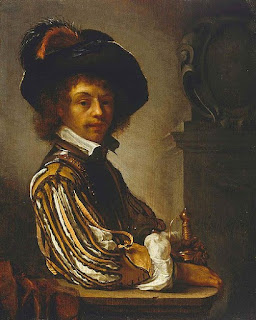Friday, June 15, 2012 -  art authentication,ARTnews,Corot,Getty Research Portal,Montreal Museum of Fine Arts,provenance
art authentication,ARTnews,Corot,Getty Research Portal,Montreal Museum of Fine Arts,provenance
 No comments
No comments
 art authentication,ARTnews,Corot,Getty Research Portal,Montreal Museum of Fine Arts,provenance
art authentication,ARTnews,Corot,Getty Research Portal,Montreal Museum of Fine Arts,provenance
 No comments
No comments
Reviewing two stolen Corot paintings and updating the catalogue raisonné of Jean-Baptiste-Camille Corot
 |
| Corot's "The Dreamer"/MMFA |
by Catherine Schofield Sezgin, ARCA Blog Editor-in-Chief
Theft and authenticity intertwined in the case of the 1972 robbery of the Montreal Museum of Fine Arts. In the years prior to the break-in, museum curators had been examining the collection and questions of authenticity had been left in the archives' files. A recent article in the June issue of ARTnews about the authenticity of paintings by Jean-Baptiste-Camille Corot (1796-1875) sent me back to my notes on two Corot oil paintings stolen in 1972 from the Montreal Museum of Fine Arts, the largest art theft in Canada. What kind of research is available to study the provenance of two missing Corot paintings?
Two oil paintings by Corot, "La rêveuse à la fontaine/The Dreamer at the Fountain" and "Jeune fille accoudée sur le bras gauche/Young Woman Resting Her Head in Her Left Hand), had both completed in the 1860s and donated a century later to the Quebec art gallery.
The museum's archives have very little information about the medium-sized paintings removed four decades ago by three thieves who entered the MMFA through a unsecured skylight on Labor Day Weekend and stole 18 paintings and 39 decorative art objects.
"The Dreamer", with its right corner signature of "COROT", was believed to have been painted between 1855-1863. The museum received the painting from an anonymous donor in memory of Mr. and Mrs. William F. Angus (steel foundry executive). In a 1969 press release, prepared for the exhibition From Daumier to Roualt, Bill Bantey -- a notorious journalist and the director of public relations for the museum -- noted that the painting 'was virtually unknown as it had been "lost" to scholarly knowledge for over 60 years in a private Montreal collection'. The other stolen Corot painting, "Young Woman Resting" was a donation in 1963 from the estate of Miss Olive Hosmer, daughter of 'multi-millionaire financier Charles S. Hosmer'. Miss Hosmer also bequeathed Jean-François Millet's signed portrait of his first wife (Portrait of Madame Millet), also taken on September 4, 1972.
 |
| Corot's "Young Woman Resting" |
The collection at Montreal's premier art gallery had been built from donations from wealthy Anglo families that had prospered from the construction of Canada's transcontinental railroad and trading from the port of Montreal. During the late 19th century and early 20th, many art dealers had offered paintings to Montreal collectors before approaching buyers in New York City. The MMFA published a book by George-Hébert Germain, A City's Museum: A History of the Montreal Museum of Fine Arts, which chronicles the growth of the art gallery founded in 1860. (Journalist and art historian Cynthia Saltzman tells of how American collectors bought up European masterpieces a century ago in her book, Old Masters, New World).
Laurie Hurwitz, writing for ARTnews, 'If It Doesn't Dance, It's Not Corot', tells of how 'a family steeped in Corot uses connoisseurship and instinct to distinguish the real paintings from copies and fakes'. Hurwitz's article features the two-decades long work of Corot expert, Martin Dieterle, and his stepdaughter, Claire Lebeau, to create a database of authentic and fake paintings by the Barbizon School painter. Alfred Robaut's four volume catalogue raisonné of Corot's work published in 1905 (you can read it online through the Getty Research Portal) identified 2,460 paintings. A supplement published in 1948 added 100 canvases. According to Dieterle, the notoriously generous artist had gifted numerous canvases to friends -- and those works had little documentation. Dieterle's connection to Corot goes back to his great-great-grandfather who painted with the artist on the Normandy coast. Other paintings not inventoried by Robaut had been those sold early on out of Corot's atelier "so it is impossible for Robaut to have known about them," Hurwitz quoted Dieterle. According to Dieterle, most copies were executed during the artists' lifetime "thus eliminating the need for forensic authentication." Dieterle and Lebeau are preparing the sixth supplement to the artist's catalogue raisonné.
Hurwitz's article is available in the June issue of ARTnews.




.jpeg)














